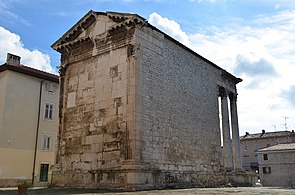Temple of Augustus, Pula
 | |
 | |
| 44°52′13″N 13°50′30″E / 44.8702°N 13.8418°E | |
| Location | Pula, Istria, Croatia |
|---|---|
| Type | Roman temple |
| Length | 17.85 metres (58.6 ft)[1] |
| Width | 8.05 metres (26.4 ft)[1] |
| Height | 14 metres (46 ft)[2] |
| Beginning date | c. 2 BC |
| Completion date | c. 14 AD |
| Dedicated to | Augustus |
The Temple of Augustus (
History
The temple was part of a triad consisting of three temples. The Temple of Augustus stood at the left side of the central temple, and the similar temple of the goddess Diana stood on the other side of the main temple. Although the larger central temple has not survived, the whole back side of the Temple of Diana is still clearly visible due to its incorporation into the Communal Palace, built in 1296.
If still in use by the 4th-century, the temple would have been closed during the persecution of pagans in the late Roman Empire. Under Byzantine rule, the temple was converted into a church, accounting for its survival to modern times, and was later used as a granary.
In the 16th century, Andrea Palladio included the description of the temple in his I quattro libri dell'architettura, a highly influential book on the principles of Classical architecture.
By the late 19th century, the temple stood at the corner of the marketplace of Pula and was partly concealed by houses, "so that the visitor cannot obtain a view till he is close to it."[2]
It was struck by a bomb during an Allied air raid in 1944, almost totally destroying it, but was reconstructed in 1947.[8] It is today used as a lapidarium to display items of Roman sculpture.[9][10]
Dedication
The temple's dedication originally consisted of bronze letters affixed by nails to the stones of the architrave.[11] Only the attachment holes now remain and much of the text has been destroyed over time. However, it consisted of a standard dedication also found on other Augustan temples, which read:
- ROMAE · ET · AVGVSTO · CAESARI · DIVI · F · PATRI · PATRIAE[12][11]
- To Roma and Augustus Caesar, son of the deity, father of the fatherland
- or
- In honour of Rome and Augustus Caesar, son of the deified [Julius], father of his country.[11]
This indicates that the temple was originally also co-dedicated to the goddess
Gallery
-
Back view
-
The temple in 2021
-
A 1924 painting by Enrico Fonda
-
An engraving from the 1760s
See also
- List of Ancient Roman temples
- Pula Arena
- Temple of Augustus in Barcelona
- Monumentum Ancyranum
- Temple of Divus Augustus
References
- notes
- references
- ^ a b c Džin 2012, p. 389.
- ^ a b Lewis 1892, p. 243.
- ^ Lewis 1892, p. 241.
- ISBN 9781566568081.
...including several temples (one of which, the first-century Temple of Augustus, is magnificently preserved)...
- ISBN 953-178-097-8
- ^ Lewis 1892, pp. 242–243.
- ISBN 0-521-09452-6
- ^ ISBN 9781841624532.
- ISBN 1-903471-79-6
- ISBN 1-74059-487-8
- ^ a b c Lewis 1892, pp. 241–242.
- ^ CIL V, 00018
- ISBN 90-04-07105-9
- ISBN 0-19-815275-2
Bibliography
- Džin, Kristina (2012). "Roman Forum Temples in Pula - Religious and Public Use". Hortus Artium Medievalium. 18 (2). .
- Urošević, Nataša (2012). "Cultural identity and cultural tourism - between the local and the global (a case study of Pula, Croatia)" (PDF). European Journal of Applied Economics. 9 (1). Singidunum University: 67–76. Archived from the original on 2016-07-16.
{{cite journal}}: CS1 maint: bot: original URL status unknown (link) - Lewis, Bunnell (1892). "The Antiquities of Pola and Aquileia". The Archaeological Journal. 44: 234–396. Archived from the original on 2016-07-18.
{{cite journal}}: CS1 maint: bot: original URL status unknown (link)
External links
![]() Media related to Temple of Roma and Augustus (Pula) at Wikimedia Commons
Media related to Temple of Roma and Augustus (Pula) at Wikimedia Commons





